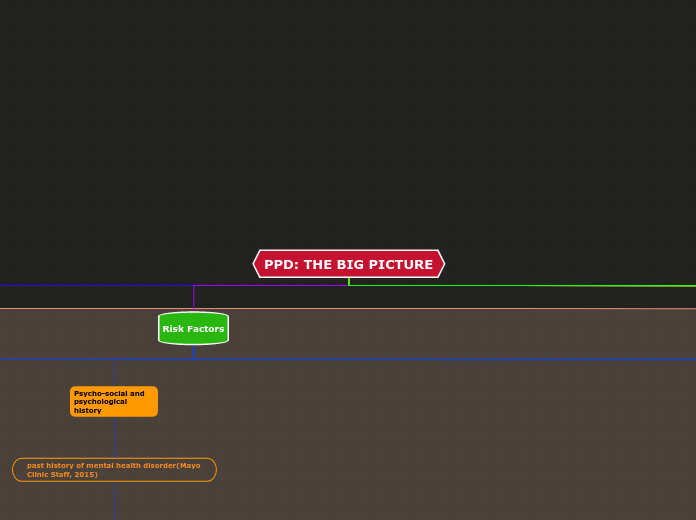PPD: THE BIG PICTURE
WHAT IS PPD
Treatable mood disorder
negatively affects the lives of mothers and their newborns
a serious mental health problem
characterized by a prolonged period of emotional disturbance, occurring at a time of major life
change and increased responsibilities in the care of a newborn infant-feelings of extreme sadness, anxiety, and exhaustio
interfere with a mother’s ability to make a meaningful connection with her newborn and care for
her newborn
difficult for mothers to complete activities of daily living for
themselves, their newborn, and for others, which can result in feelings of detachment from their
newborn and family
begins before or any time after childbirth,between one week and one month after delivery
If left untreated- can last for a period of time, often months or
years, sometimes becoming a chronic depressive disorder-may be life-threatening
woman can potentially risk harming
themselves or their baby
Main topic
Risk Factors
Socio Demographic factors
More details
Preg and birth related
medical complications during the childbirth process or mixed feelings about the
pregnancy
Newborn related factors
Describing word
Marital and family relationship
Relationship adjustment
satisfaction, interactions, and behaviors between spouses and domestic partners (Fast Track Project, 2011)
Spanier Dyadic Adjustment Scale (1976)- relationship adjustment was lower/depressive and anxiety symptoms
tended to be higher
A lack of strong emotional support from a spouse, partner, family, or
friends
Marital satisfaction
less satisfaction in marriages,
increased worry about family responsibilities, and greater dissatisfaction in changes in household
routines, recreation, and intimacy with their partners
indicating less satisfaction with
parenthood and more concerned about changes in intimacy with their spouses.
Psycho-social and psychological history
past history of mental health disorder(Mayo Clinic Staff, 2015)
Past History indicate higher levels of psychiatric symptoms amongppd women
Disorders
major depressive disorder
(Stein and colleagues (2012)) mothers who have a past history of major depressive disorder prior to
giving birth responded less to their child’s vocalization (cries, coos, etc.)
heightened psychiatric symptoms, higher levels of depressive
symptomatology, and greater anxiety is observed (Weinberg et al., 2001).
prenatal
anxiety
Anxiety before birth,
ecognized as feelings of guilt,
feelings of chronic anxiety, a lack of energy, persistent crying, isolation, and worries about the
relationship (PANDAS Foundation, 2014).
symptoms can be an indicator of
potential infant attachment.
anxiety experienced postpartum
Weinberg and colleagues (2001) - more negative and less positive affect with higher
depressive symptoms, higher anxiety levels, and greater psychiatric symptoms
depressive symptomology
lesbian birth mothers/co-mothers
Zelkowitz and
Milet’s (1996) findings that when a woman experiences psychiatric symptoms postpartum, her
partner is more likely to experience similar symptoms postpartum
Describing word
Subtopic
Edinburgh Postnatal Depression Scale (EPDS)
Describing word
Stress
Stressful life events during pregnancy or shortly
after giving birth have also shown to be indicative of postpartum depression
physical, emotional and behavioral problems that
can negatively affect a person’s mind and health
Maternal related stress
Negatively affect newborns
Smaller birth weight,
ncreased risk for miscarriage
infant temperamental problems
and fussiness
emotional problems in girls and boys can be a factor in an newborn’s potential
future development of mental health disorders such as schizophrenia and severe depression
Culture
x
Little research found unplanned Cesarean sections can be traumatic upon both the mother and baby(American Psychological Association, 2015)
x
Main topic
Effect of PPD
In Mothers
Describing word
In Fathers
Describing word
Subtopic
Describing word
In Infants
Describing word
Next POINT
Describing word
Consequences
1
Describing word
2
Describing word
Treatment Stategies
social support from
other mothers, friends, and relatives
Making sure new mothers are getting sufficient rest, sleep,
and cutting down on less important responsibilities
cognitive-behavioral therapy
and interpersonal therapy
Describing word
Survey
Questions
Describing word
=
Describing word
Next
Describing word
